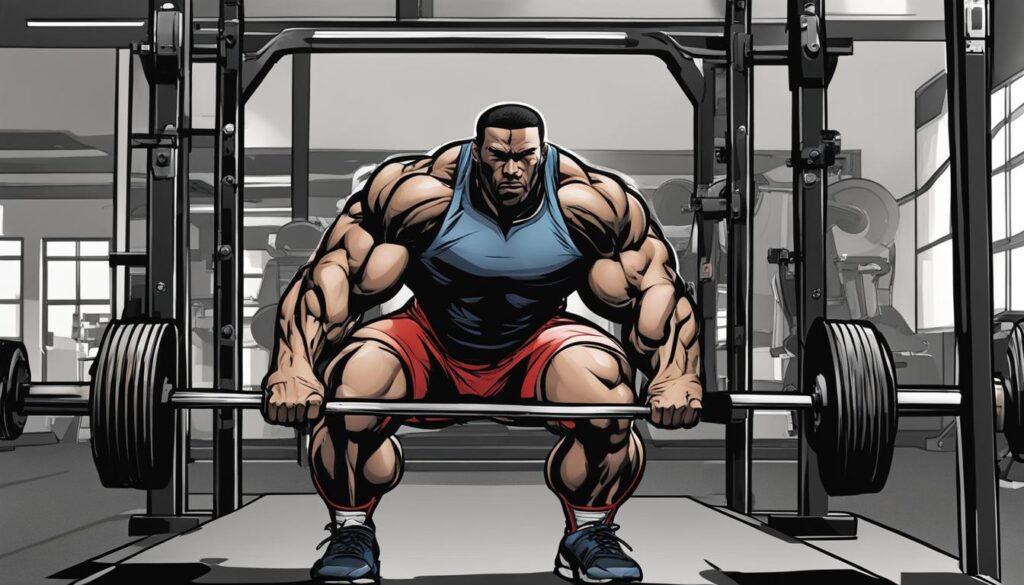What You Need to Know About deadlift muscles worked
Are you looking to take your strength and fitness to the next level? Look no further than the deadlift, a fundamental pull exercise that engages multiple muscle groups for maximum results. But have you ever wondered which muscles are truly worked during this powerful movement? Let’s dive deep and uncover the secrets behind deadlift muscles worked and how they can transform your fitness journey.
Key Takeaways:
- The deadlift is a compound exercise that targets the muscles in the posterior chain, including the back, glutes, and hamstrings.
- Primary muscles engaged during the deadlift include the erector spinae, gluteus maximus, hamstrings, and quadriceps.
- In addition to the lower body, the grip muscles and upper body also contribute to stabilizing the movement.
- Incorporating deadlifts into your routine can lead to increased strength, improved posture, and enhanced overall functional fitness.
- Proper form and technique are crucial for maximizing the benefits and minimizing the risk of injury during deadlifts.
Understanding the Deadlift Exercise
Before we delve into the specific muscles worked during the deadlift, let’s first understand the mechanics of this exercise. The deadlift is a compound movement that primarily targets the muscles in the posterior chain, including the back, glutes, and hamstrings. It is a pulling exercise that involves gripping the barbell and lifting it from the ground to a standing position.
The deadlift is considered one of the most effective pull exercises for developing overall strength and muscle mass. It engages multiple muscle groups in the body, making it a highly efficient workout.
Deadlift Mechanics
To perform a deadlift, start by standing with your feet shoulder-width apart and the barbell on the ground in front of you. Keep your back straight and core engaged. Bend your knees and hinge at the hips, maintaining a neutral spine position.
As you grip the barbell, make sure your hands are slightly wider than shoulder-width apart. Your palms can face down (overhand grip), or one palm can face up and the other down (mixed grip). Having a solid grip on the bar is essential for a successful deadlift.
When you’re ready, push through your heels and lift the barbell by extending your hips and straightening your legs. As you lift, engage your back, glutes, and hamstrings to drive the movement. Keep the barbell close to your body throughout the exercise to maintain proper form and reduce the risk of injury.
“The deadlift is a foundational exercise that targets multiple muscle groups, making it an excellent choice for overall strength and muscle development.” – Fitness Expert
At the top of the movement, stand tall with your shoulders pulled back and the barbell in full extension. Slowly lower the barbell back down to the ground in a controlled manner, maintaining proper form and body alignment.
It’s important to note that the deadlift can be modified to suit individual fitness levels and goals. Variations, such as the sumo deadlift and Romanian deadlift, target different muscle groups while still providing similar benefits.
Now that we have a better understanding of how the deadlift exercise works and its mechanics, let’s explore the specific muscles that are engaged during this compound movement in the next section.
Primary Muscles Engaged in the Deadlift
The deadlift is a compound exercise that activates multiple muscle groups, making it an excellent choice for full-body strength and development. Let’s take a closer look at the primary muscles worked during the deadlift.
The Posterior Chain
The deadlift primarily targets the muscles in the posterior chain. These muscles are located on the back side of the body and include the erector spinae in the lower back, the gluteus maximus in the buttocks, and the hamstrings at the back of the thighs.
The erector spinae muscles play a crucial role in maintaining a neutral spine during the deadlift, providing stability and preventing injury. The gluteus maximus is the largest muscle in the body and is responsible for hip extension, which is essential for lifting the weight off the ground. The hamstrings work in conjunction with the glutes to control the movement and assist in hip extension.
The Quadriceps
Although the deadlift primarily targets the posterior chain, it also engages the quadriceps at the front of the thighs. These muscles help to extend the knees and play a supporting role in the lifting process.
The grip muscles and the upper body also come into play during the deadlift, working to stabilize the movement and maintain control throughout the exercise.
To visualize the primary muscles engaged during the deadlift, refer to the table below:
| Muscle Group | Primary Muscles |
|---|---|
| Posterior Chain | Erector Spinae, Gluteus Maximus, Hamstrings |
| Quadriceps | Rectus Femoris, Vastus Lateralis, Vastus Medialis, Vastus Intermedius |
| Grip and Upper Body | Forearm Flexors, Latissimus Dorsi, Trapezius, Rhomboids |

The deadlift is a highly effective exercise for building overall strength, enhancing muscle development, and improving functional fitness. By engaging the primary muscles mentioned above, the deadlift provides a full-body challenge and promotes strength gains in key areas.
A proper deadlift targets the posterior chain, quadriceps, and upper body muscles, making it a comprehensive exercise for building strength and stability.
Benefits of Deadlift for Overall Strength and Fitness
Incorporating deadlifts into your workout routine can have numerous benefits for your overall strength and fitness. This compound exercise targets major muscle groups, promoting strength gains in the back, glutes, hamstrings, and quads. Additionally, deadlifts help improve posture, increase grip strength, boost athletic performance, and enhance overall functional fitness.
Deadlifts are a highly effective exercise for developing strength and power. By engaging multiple muscle groups simultaneously, such as the back, glutes, hamstrings, and quads, deadlifts can lead to substantial gains in overall strength and fitness. The deadlift is a compound movement that activates both the lower and upper body, making it a highly efficient exercise for maximizing caloric expenditure and promoting muscle growth.
One of the key benefits of deadlifts is their ability to improve posture. The exercise targets the muscles responsible for keeping the spine stable and erect, such as the erector spinae. Regular deadlift training can help strengthen these muscles, leading to better posture and decreased risk of back pain or injury.
Another advantage of deadlifts is their ability to increase grip strength. Holding onto a loaded barbell during a deadlift requires a significant amount of grip strength and forearm activation. By regularly performing deadlifts, you can develop a strong grip that can carry over to other exercises and activities, such as lifting weights or participating in sports.
Deadlifts are also valuable for improving athletic performance. The movement pattern and muscle activation involved in deadlifting closely mimic many real-life activities and sports movements. By strengthening the muscles involved in these movements, deadlifts can enhance explosive power, speed, and agility, leading to improved athletic performance in various sports.
Furthermore, deadlifts contribute to overall functional fitness, which refers to the ability to perform daily activities and tasks with ease and efficiency. By targeting multiple muscle groups and movements in a coordinated manner, deadlifts train the body to move and function as a unit. This can improve performance in everyday activities, such as lifting heavy objects, climbing stairs, or bending down to pick up items.
In summary, incorporating deadlifts into your workout routine can provide a plethora of benefits for your overall strength and fitness. This compound exercise targets major muscle groups, improves posture, increases grip strength, boosts athletic performance, and enhances overall functional fitness. However, it’s important to consult with a fitness professional to ensure proper form and technique when performing deadlifts to minimize the risk of injury and maximize the benefits.
Performing Deadlifts Properly
To maximize the benefits of deadlifts and minimize the risk of injury, it is crucial to perform the exercise with proper form. Here are some key tips to ensure you get the most out of your deadlift workout at the gym:
- Start with the right weight: Choose a weight that you can comfortably lift while maintaining proper form.
- Maintain a neutral spine: Focus on keeping your spine in a neutral position throughout the movement. Avoid rounding or arching your back.
- Engage your core: Activate your core muscles to provide stability and support during the exercise.
- Hinge at the hips: Initiate the movement by hinging at the hips, pushing your buttocks back while keeping your chest lifted.
- Drive through your heels: As you lift the barbell, push through your heels to generate power and maintain stability.
Proper technique is essential for optimizing the benefits of deadlifts and preventing injury. If you’re new to deadlifting or are unsure about your form, consider working with a knowledgeable fitness professional who can guide you through the correct technique.
Conclusion
The deadlift is a highly effective compound exercise that targets multiple muscles in the posterior chain, including the back, glutes, and hamstrings. By incorporating deadlifts into your regular workout routine, you can significantly enhance your overall strength and fitness levels. This fundamental pull exercise engages major muscle groups, promoting strength gains and increasing muscular endurance.
When performing deadlifts, it is crucial to prioritize proper form and technique to ensure both safety and optimal results. Start with a weight that allows you to maintain proper form throughout the movement, and focus on maintaining a neutral spine and engaging your core. Remember to hinge at the hips, drive through your heels, and stand tall, utilizing the power of your legs, glutes, and back.
Not only does the deadlift improve muscle strength and power, but it also has numerous benefits for your overall fitness. This exercise helps improve posture, increase grip strength, and enhance functional fitness, making your day-to-day activities easier and more efficient. Deadlifts are a versatile exercise that can be modified to suit various fitness levels and goals, making them a valuable addition to any workout routine.
In conclusion, the deadlift is a cornerstone exercise for building strength, improving fitness, and targeting the muscles of the posterior chain. Incorporate deadlifts into your training regimen, under proper guidance, to achieve impressive strength gains and take your fitness journey to new heights. Remember to prioritize proper form, stay consistent, and enjoy the transformative benefits this exercise has to offer!
FAQ
What muscles are worked during a deadlift?
The deadlift primarily engages the muscles in the posterior chain, including the erector spinae in the lower back, the gluteus maximus in the buttocks, the hamstrings at the back of the thighs, and the quadriceps at the front of the thighs. The grip muscles and the upper body also contribute to stabilizing the movement.
How does the deadlift exercise benefit overall strength and fitness?
Incorporating deadlifts into your workout routine can lead to significant strength gains in the back, glutes, hamstrings, and quads. Deadlifts also improve posture, increase grip strength, enhance athletic performance, and promote overall functional fitness.
What is the proper form for performing deadlifts?
To perform deadlifts properly, start with a weight that you can comfortably lift. Maintain a neutral spine throughout the movement by engaging your core. Hinge at the hips and drive through your heels to stand tall. It is advisable to work with a knowledgeable fitness professional to learn and practice the correct technique.
